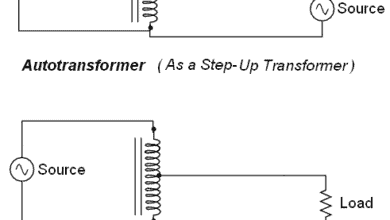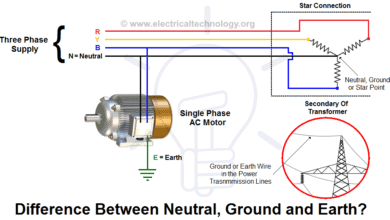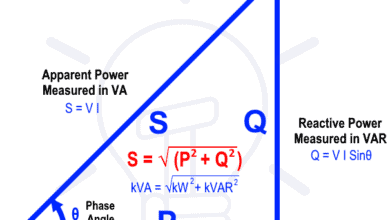Ferranti Effect – Causes, Circuit Diagram, Advantages & Disadvantages
Ferranti Effect in Power Lines: Circuit Diagram, Causes, Effects, Controlling, Advantages and Disadvantages
As we know that electricity is generated at power generation plants using huge electromechanical generators by conversion from other forms of energy. This electrical energy is then transmitted over a long-distance transmission line to end users. The electrical power transmission lines require multiple safety devices and components to ensure the safety of the connected loads and personnel as well as maximize the efficiency of the power transmission and distribution system.
The transmission line faces various kinds of losses and phenomena that affect its efficiency. One such phenomenon that greatly impacts the transmission line is Ferranti Effect.
Generally, we assume that the voltage always drops in the transmission lines due to the line losses. Ferranti Effect causes the receiving voltage to be greater than the sending voltage in a long-distance transmission line that has a very light load or no load at all. This article explains the causes, benefits, drawbacks, etc. of the Ferranti effect.
What is Ferranti Effect?
The Ferranti effect is a phenomenon in which the voltage at the receiving end (load side) is greater than the voltage at the sending end (source or generating side) of a long transmission line or cable during light load or no load conditions. The rise in voltage is due to more reactive power being generated by the line capacitance in the power lines than the power being consumed.
The Ferranti effect was discovered by British electrical engineer Sebastian Ziani de Ferranti in 1887. He observed a rise in the voltages at certain points in the London power system. He observed that the medium to long transmission power cables having light load or no loads has greater receiving voltage Vr than the sending voltage Vs. it does not occur in short transmission lines.
In short, the receiving end voltage of an unloaded power line being greater than the sending end voltage due to the line capacitance is known as Ferranti effect.
Related Posts:
- Corona Effect & Discharge in Transmission Lines & Power System
- Skin Effect and Factors Affecting Skin Effect in Power Lines
What Causes Ferranti Effects?
Ferranti Effect mainly occurs due to the presence of a huge charging current due to the capacitance of the transmission line. Although different factors affect the current in the transmission line. However, Ferranti Effect occurs due to the following three reasons;
- Transmission line capacitance
- Load at the receiving end
- Supply Frequency
Transmission Line Capacitance
The conductors in the transmission line are placed in closed proximity, especially in underground cables that develop capacitance between them. In fact, the transmission cable constitutes many shunt capacitors and series inductors equally distributed along the length of the cable. The capacitance increases with an increase in the length of the transmission line. The capacitors draw a large amount of charging current that flows through the whole length of the line. The capacitor generates reactive power that flows in opposite direction toward the source. The inductors in the line consume the reactive power causing a voltage drop across them. The voltage drop is in-phase with the sending voltage. Therefore the voltages add up and the receiving voltage is increased.
The Ferranti effect depends on the length of the transmission line and the type of cable being used. Here is a table chart showing details.
| Type of Transmission line | Length of Transmission line | Nature of Impedance | Ferranti Effect | Reasons |
| Overhead | Short transmission line
< 50 miles or 80 km |
Resistive and inductive | No | Short transmission lines have very small negligible capacitance, thus negligible charging current and No Ferranti effect. |
| Overhead | Medium transmission line
50 to 100 miles 80 to 160 km |
Resistive, inductive and capacitive | Yes | Medium transmission lines have a high capacitance that develops a large charging current and causes Ferranti effect. |
| Overhead | Long transmission line
> 100 miles or 160 km |
Resistive, inductive and capacitive | Yes | Long transmission lines have very high capacitance and very large charging current thus Ferranti effect is more prominent. |
| Underground | Multicolor cables | Resistive, inductive and capacitive | Yes | Cables include conductor in very close proximity to those of overhead lines that develop very high charging current and Ferranti effect. |
Related Posts:
- Types of Insulators used in Power Transmission and Overhead Lines
- Classification of Electric Power Distribution Network Systems
Connected Load
The Ferranti effect also depends on the load connected at the receiving end. The load can be in either three conditions
- No load
- Light load
- Full load
Under no load condition, there is only a charging current and no load current flowing through the transmission line. The charging current is drawn by the shunt capacitors in the line. It generates reactive power that causes a voltage drop across the inductor that is in-phase with the sending voltage and increases the voltage at the receiving end.
When light load is connected, there is a very low load current as compared to the charging current flowing through the lines. Due to the line capacitance, the charging current is leading in nature. The capacitor generates reactive power that flows through the inductors which is greater than the reactive power consumed by the inductors due to low load current. The voltage drop across the inductors is almost in phase with the source voltage and it is proportional to the charging current. As the charging current is higher than the load current, the Ferranti effect occurs.
In full load conditions, the load current is higher than the charging current drawn by the capacitor (it is almost constant). Since a large load current is flowing through the series inductors, the reactive power consumed by the inductor is larger than the reactive power generated by the capacitor. Therefore the net reactive power is negative and the voltage decreases at the receiving end.
Supply Frequency
As we know that the Ferranti effect occurs due to the reactive power generated in the shunt capacitance of the power lines. However reactive power only occurs if supply voltage and current has some frequency. Since DC has zero frequency, there is no Ferranti effect. We can say that transmission lines that operate at high frequency are more prone to the Ferranti effect.
Related Posts:
- What is Sag in Overhead Power Transmission Lines?
- What are the Effects of Temperature on Sag in Overhead Lines?
Circuit Diagram, Phasor Diagram & Equation for Ferranti Effects
Let’s consider the equivalent circuit diagram of a long transmission line. Since a long transmission line is composed of high capacitance and inductance distributed throughout the whole length of the line, this diagram represents the parameters per kilometer of length. Therefore the capacitance and inductance are proportional to the length of the line. The shunt capacitors are in parallel while the inductors are in series with the power lines as shown below.
The parameters in the given circuit diagram are
- Vs = Sending or source Voltage (Generating End)
- Vr = Receiving Voltage
- Is = Sending or Source Current
- Ir = Receiving Current
- Ic = Capacitive or Charging Current
- R = Resistance of line
- Xc = Capacitive reactance of the line
- XL = inductive reactance of the line
- C = Capacitance of line
- L = inductance of the line
Let’s look at the phasor diagram of the given circuit. During the Ferranti effect, there is no load therefore
Receiving current Ir = 0
Is = Ic
The receiving voltage Vr is taken as reference OA where the capacitive current Ic is represented by perpendicular line OD leading the Vr by 90°. The capacitive current Ic has a voltage drop across the line resistance R and line inductance L given by
Voltage drop across resistor = IcR = represented by AB
Voltage drop across inductor = IcXL = represented by BC
The inductive voltage drop IcXL (BC) leads the resistive voltage drop IcR (AB) by 90°. Where the sending voltage Vs is the sum of all voltage drops + receiving voltage represented by OC.
Vs = Vr + Resistive voltage drop + Inductive voltage drop
Vs = OA + AB + BC = OC
As shown in the phasor diagram, the receiving voltage Vr at the load side is greater than the sending voltage Vs at the source side.
Now let’s derive the equation for the Ferranti effect using the equivalent circuit diagram of the transmission line.
Vs = Vr + resistive drop + inductive drop
Vs = Vr + IcR + IcXL
Vs = Vr + Ic (R + XL)
Since capacitive current, Ic = jwCVr
Vs = Vr + jwCVr (R + XL)
Since XL = jwL
Vs = Vr + jwCVr (R + jwL)
Vs = Vr + jwCVrR + j2w2CLVr
Vs = Vr + jwCVrR – w2CLVr
Vs – Vr = jwCVrR – w2CLVr
In long transmission lines, the line resistance is much smaller than the line reactance. Therefore the resistance R, as well as the resistive voltage drop is neglected
Vs – Vr = -w2CLVr
Now assume the capacitance and inductance per km of the length are Co and Lo respectively and the length of the transmission line is l. The equation becomes
Vs – Vr = -w2(Col)(Lol)Vr
Vs – Vr = -w2l2 CoLoVr
Since the line capacitance is distributed throughout the whole length (l) of the transmission line, the charging current, as well as the voltage drop associated with it, is taken as average. Therefore;
Vs – Vr = – (1/2) w2l2 CoLoVr
The voltage difference between the sending and receiving voltage is negative which means the voltage rises. And it is directly proportional to the square of frequency (w), the square of line length (l). This equation proves that the Ferranti effect increases with an increase in the length of the transmission line and supply frequency. Therefore small transmission lines and HVDC transmission are not affected by the Ferranti effect.
Related Posts:
- What is Power Factor (Cos ϕ) ? Cos fi or P.F Definition & Formulas
- Active, Reactive, Apparent and Complex Power
How to Reduce Ferranti Effect?
Ferranti effect creates voltage instability in the electrical system that creates a hazardous situation for equipment and personnel at the load side. There are certain measures taken to minimize the Ferranti effect.
Shunt Reactor
Ferranti effect occurs due to the generation of reactive power in the power system and there are no loads to absorb this reactive power. We need to install something in the transmission line that can absorb this excessive reactive power. A shunt reactor can absorb this reactive power by installing it in the transmission line. It is usually installed at the load end.
A medium transmission line requires the shunt reactor to be placed at the receiving end. However long transmission lines require it to be installed at a periodic distance or in the middle of the line. Whereas underground cables have very high capacitance and require relatively very short distance of around 10 miles or 15 km intervals.
Load Management
Ferranti effect occurs when there is no or light load connected with the lines. To reduce the Ferranti effect, it must fulfill the given condition.
Load current > Charging current.
The loads in a transmission line should be monitored continuously and the load must be ensured to be kept above the limit. It can be done by placing multiple light load lines onto a single line.
Advantages & Disadvantages of Ferranti Effects
Advantages
The Ferranti effect does not have many advantages but disadvantages. However, some of them are given below.
Reduced Copper losses
The copper loss is the power loss in the lines due to the current flowing through them. It appears in the form of heat. It depends on the amount of current flowing through the line and is given by
Copper loss = I2R
As the charging current Ic is leading in nature and the inductive current IL is lagging. The vector sum of both current cancel each other and decrease the load current to some extent.
In no or light load conditions, the capacitive current is greater than the inductive current. Therefore the net load current Inet phase is more inclined towards the capacitive current. Since the load current is decreased, the copper losses also decrease.
Power Factor Improvement
Power factor occurs due to the phase angle of the capacitive current and inductive current. As the capacitive current reduces the effect of the inductive current. Therefore the net current is mostly composed of resistive current which improves the power factor.
Disadvantages
The Ferranti effect has many disadvantages such as:
Over Voltage
The Ferranti effect increases the sending voltage when it is received at the load end of the transmission line. The increase in voltage can damage any load connected with the system. Since every load is designed to operate at a nominal voltage. Overvoltage can damage insulation and drastically reduce the lifetime of equipment and it can permanently damage the load.
Voltage Regulation
It increases the voltage regulation which must be near zero.
Efficiency
It reduces the efficiency of the transmission line by reducing the amount of load current flowing through it. The charging current takes most of the ampacity of the line conductor thus reducing its efficiency.
Related Posts:
- Skin Effect Calculator
- Differences Between HVAC and HVDC – Power Transmission
- Advantages of HVDC over HVAC Power Transmission
- What is Joule’s Law and Heating Effect of Current
- Introduction to Harmonics – Effect of Harmonics on Power System
- Why Volume of the Conductor is Inversely Proportional to the Square of Voltage?
- Why Don’t Birds and Squirrels Get Electrocuted on Power Lines?
- Why is Electric Power Transmission Multiple of 11 i.e. 11kV, 22kV, 66kV etc.?
- What are the Colored Aerial Marker Balls on Power Lines For?
- Electric Power System – Generation, Transmission & Distribution of Electricity










